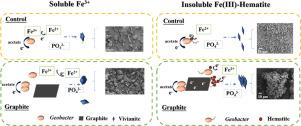Water Research ( IF 11.4 ) Pub Date : 2020-11-23 , DOI: 10.1016/j.watres.2020.116663 Yu Wu , Cong Wang , Shu Wang , Jingkun An , Danhui Liang , Qian Zhao , Lili Tian , Yue Wu , Xin Wang , Nan Li

|
Biomineralized vivianite induced by dissimilatory iron reduction bacteria (DIRB) has received increasing attention because it alleviates phosphorus crisis and phosphorus pollution simultaneously. However, the relatively small crystal size and low Fe(Ⅲ) reduction rate restrict the separation and recovery of vivianite. In this study, graphite was selected as additive to enhance vivianite biomineralization with soluble ferric citrate and insoluble hematite as two representative electron acceptors. As soluble ferric citrate provided abundant accessible electron acceptors, relatively inconspicuous increase (lower than 7%) was observed for graphite on vivianite formation while inoculated with raw sewage or DIRB. In contrast, graphite considerably increased vivianite formation efficiency by 23% in insoluble hematite inoculated with raw sewage. The graphite promotion on vivianite formation in hematite batch was magnified to 70% by DIRB. Dosing hematite inhibited the supply of electron acceptors, while conductive graphite promoted the electrical connection between minerals and DIRB, thus improved the Fe(III) reduction rate and efficiency. In addition, secondary minerals in hematite exhibited a larger aspect ratio and tended to aggregate on graphite. Graphite enlarged the vivianite size in hematite from 10 µm to 90 µm due to aggregation. Enhancing dissimilatory iron reduction (DIR) rate of iron oxides and enlarging crystal size provide new insights for vivianite formation and separation during wastewater treatment.
中文翻译:

石墨加速异化铁还原和Vivianite晶体扩大
异化铁还原细菌(DIRB)诱导生物矿化的维维石受到越来越多的关注,因为它同时缓解了磷危机和磷污染。然而,相对较小的晶体尺寸和较低的Fe(Ⅲ)还原速率限制了堇青石的分离和回收。在这项研究中,选择了石墨作为添加剂,以可溶性柠檬酸铁和不溶性赤铁矿作为两个代表性的电子受体,增强了堇青石的生物矿化作用。由于可溶性柠檬酸铁提供了丰富的可利用电子受体,因此在用原污水或DIRB进行接种时,石墨在维维石形成时观察到相对不明显的增加(低于7%)。相比之下,石墨显着提高了用原污水接种的不溶性赤铁矿中的堇青石形成效率,提高了23%。用DIRB将石墨对赤铁矿批料中的堇青石形成的促进作用放大到70%。定量添加赤铁矿抑制了电子受体的供应,而导电石墨促进了矿物与DIRB之间的电连接,从而提高了Fe(III)的还原率和效率。另外,赤铁矿中的次生矿物具有较大的长径比,并且倾向于聚集在石墨上。由于聚集,石墨使赤铁矿中的vi石尺寸从10 µm扩大到90 µm。增强氧化铁的异化铁还原(DIR)速率和增大晶体尺寸,为废水处理过程中的维维亚石形成和分离提供了新的见解。导电石墨促进了矿物与DIRB之间的电连接,从而提高了Fe(III)的还原率和效率。另外,赤铁矿中的次生矿物具有较大的长径比,并且倾向于聚集在石墨上。石墨由于聚集而使赤铁矿中的vian石尺寸从10 µm扩大到90 µm。增强氧化铁的异化铁还原(DIR)速率和增大晶体尺寸,为废水处理过程中形成和分离堇青石提供了新的见识。导电石墨促进了矿物与DIRB之间的电连接,从而提高了Fe(III)的还原率和效率。另外,赤铁矿中的次生矿物具有较大的长径比,并且倾向于聚集在石墨上。由于聚集,石墨使赤铁矿中的vi石尺寸从10 µm扩大到90 µm。增强氧化铁的异化铁还原(DIR)速率和增大晶体尺寸,为废水处理过程中的维维亚石形成和分离提供了新的见解。











































 京公网安备 11010802027423号
京公网安备 11010802027423号